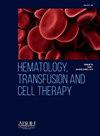PSMA PET/CT FOR DETECTING BRAIN METASTASIS IN ESOPHAGEAL CANCER: A CASE REPORT
IF 1.8
Q3 HEMATOLOGY
引用次数: 0
Abstract
Introduction/Justification
PET/CT with prostate-specific membrane antigen (PSMA) has been investigated in various scenarios beyond prostate cancer, with PSMA expression reported in multiple solid tumor tissues, including their neovascular endothelium.[1] We present the case of a patient with esophageal cancer who developed brain metastasis, emphasizing the critical role of 18 F-PSMA PET/CT imaging in detecting metastatic lesions and its potential impact on guiding treatment strategies.
Report
G. H. B., a 71-year-old Brazilian male with a history of smoking, alcohol consumption and gastroesophageal reflux disease, was diagnosed with esophagogastric adenocarcinoma in 2024. 18 F-FDG PET/CT staging revealed a localized neoplasm at the esophagogastric junction (6.4 cm, SUV=15.1) and regional paratracheal lymphadenopathy (SUV = 17.2), with no evidence of distant metastasis. The patient initiated neoadjuvant chemotherapy with the FLOT regimen (fluorouracil, leucovorin, oxaliplatin, and docetaxel) and after four cycles, he underwent 18 F-FDG and 18 F-PSMA PET/CT. 18 F-FDG PET/CT revealed disease progression with increased primary lesion metabolic activity, new paratracheal lymphadenopathy and a right temporal lobe lesion consistent with metastasis. In comparison, 18 F-PSMA PET/CT showed higher 18 F-PSMA uptake in the temporal lobe lesion, similar uptake in the distal esophagus, and reduced uptake in the mediastinal lymph nodes. The multidisciplinar team contraindicated esophagectomy, recommending radiotherapy for the central nervous system metastasis over neurosurgery, and palliative systemic treatment.
Conclusion
To our knowledge, this is the first reported case of brain metastasis from esophageal cancer identified using 18 F-PSMA PET/CT. The increased 18 F-PSMA uptake in the brain lesion, compared to 18 F-FDG PET/CT, may be attributed to PSMA overexpression in the neovascular endothelium of non-prostate cancers.[2] 18 F-PSMA PET/CT represents a novel diagnostic tool for non-prostate cancers, potentially offering higher sensitivity for detecting brain metastases than 18 F-FDG PET/CT. Further clinical trials are warranted to investigate its role in gastrointestinal malignancies.
导言/理由前列腺特异性膜抗原(PSMA)PET/CT已在前列腺癌以外的各种情况下进行了研究,有报道称PSMA在多种实体瘤组织中表达,包括其新生血管内皮[1]。我们介绍了一例发生脑转移的食管癌患者,强调了18 F-PSMA PET/CT成像在检测转移病灶中的关键作用及其对指导治疗策略的潜在影响。H. B. 是一名 71 岁的巴西男性,有吸烟、饮酒和胃食管反流病史,于 2024 年被诊断为食管胃腺癌。18 F-FDG PET/CT 分期显示食管胃交界处有局部肿瘤(6.4 厘米,SUV=15.1)和区域性气管旁淋巴结病(SUV=17.2),无远处转移证据。患者接受了FLOT方案(氟尿嘧啶、亮菌素、奥沙利铂和多西他赛)的新辅助化疗,四个周期后,他接受了18 F-FDG和18 F-PSMA PET/CT检查。18 F-FDG PET/CT 显示疾病进展,原发病灶代谢活动增加,出现新的气管旁淋巴结病变,右颞叶病变与转移一致。相比之下,18 F-PSMA PET/CT 显示颞叶病灶的 18 F-PSMA 摄取率较高,食管远端摄取率相似,纵隔淋巴结摄取率降低。据我们所知,这是首例利用 18 F-PSMA PET/CT 发现的食管癌脑转移病例。与 18 F-FDG PET/CT 相比,脑部病变中 18 F-PSMA 摄取增加,这可能是由于非前列腺癌新生血管内皮中 PSMA 过度表达所致。有必要进一步开展临床试验,研究其在胃肠道恶性肿瘤中的作用。
本文章由计算机程序翻译,如有差异,请以英文原文为准。
求助全文
约1分钟内获得全文
求助全文
来源期刊

Hematology, Transfusion and Cell Therapy
Multiple-
CiteScore
2.40
自引率
4.80%
发文量
1419
审稿时长
30 weeks
 求助内容:
求助内容: 应助结果提醒方式:
应助结果提醒方式:


